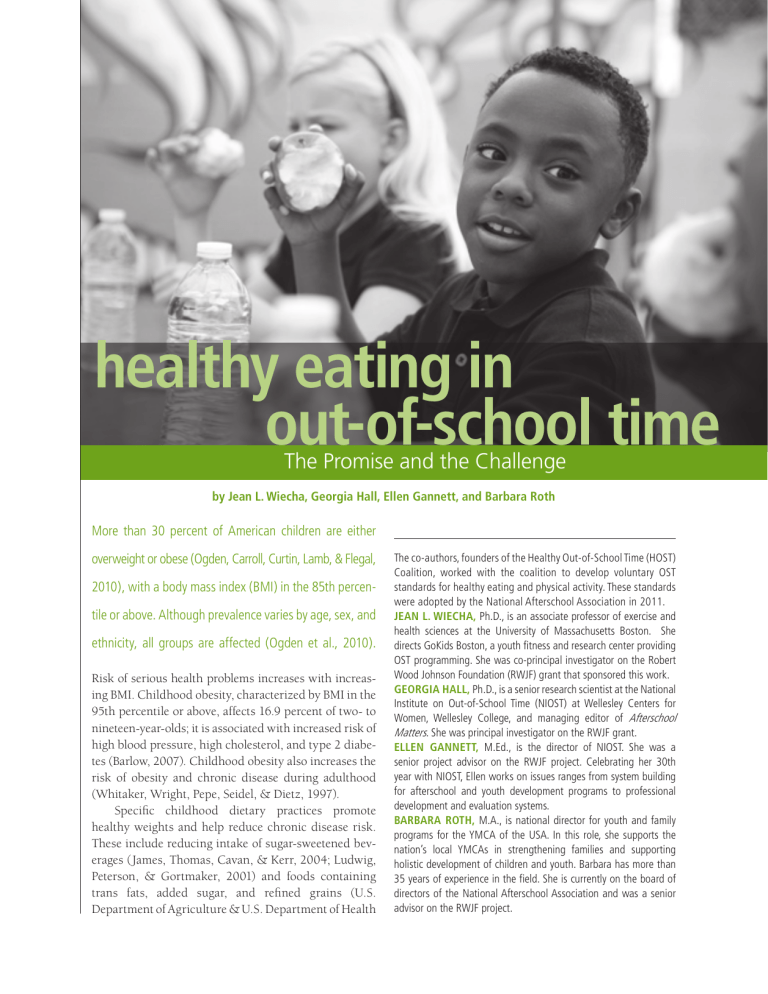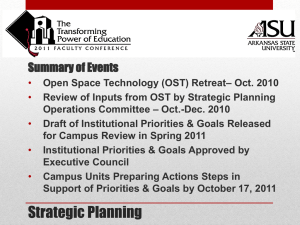healthy eating in out-of-school time The Promise and the challenge
advertisement

healthy eating in out-of-school time The Promise and the Challenge by Jean L. Wiecha, Georgia Hall, Ellen Gannett, and Barbara Roth More than 30 percent of American children are either overweight or obese (Ogden, Carroll, Curtin, Lamb, & Flegal, 2010), with a body mass index (BMI) in the 85th percentile or above. Although prevalence varies by age, sex, and ethnicity, all groups are affected (Ogden et al., 2010). Risk of serious health problems increases with increasing BMI. Childhood obesity, characterized by BMI in the 95th percentile or above, affects 16.9 percent of two- to nineteen-year-olds; it is associated with increased risk of high blood pressure, high cholesterol, and type 2 diabetes (Barlow, 2007). Childhood obesity also increases the risk of obesity and chronic disease during adulthood (Whitaker, Wright, Pepe, Seidel, & Dietz, 1997). Specific childhood dietary practices promote healthy weights and help reduce chronic disease risk. These include reducing intake of sugar-sweetened beverages (James, Thomas, Cavan, & Kerr, 2004; Ludwig, Peterson, & Gortmaker, 2001) and foods containing trans fats, added sugar, and refined grains (U.S. Department of Agriculture & U.S. Department of Health The co-authors, founders of the Healthy Out-of-School Time (HOST) Coalition, worked with the coalition to develop voluntary OST standards for healthy eating and physical activity. These standards were adopted by the National Afterschool Association in 2011. Jean L. Wiecha, Ph.D., is an associate professor of exercise and health sciences at the University of Massachusetts Boston. She directs GoKids Boston, a youth fitness and research center providing OST programming. She was co-principal investigator on the Robert Wood Johnson Foundation (RWJF) grant that sponsored this work. Georgia Hall, Ph.D., is a senior research scientist at the National Institute on Out-of-School Time (NIOST) at Wellesley Centers for Women, Wellesley College, and managing editor of Afterschool Matters. She was principal investigator on the RWJF grant. Ellen Gannett, M.Ed., is the director of NIOST. She was a senior project advisor on the RWJF project. Celebrating her 30th year with NIOST, Ellen works on issues ranges from system building for afterschool and youth development programs to professional development and evaluation systems. Barbara Roth, M.A., is national director for youth and family programs for the YMCA of the USA. In this role, she supports the nation’s local YMCAs in strengthening families and supporting holistic development of children and youth. Barbara has more than 35 years of experience in the field. She is currently on the board of directors of the National Afterschool Association and was a senior advisor on the RWJF project. guidelines and other managerial supports in helping proand Human Services, 2010). The American Academy of grams adopt healthy eating practices. Pediatrics recommends that children eat a healthy breakfast and five or more fruits and vegetables daily. Other recommendations include letting children reguMethods late their own intake and engaging the whole family in The research team, consisting of the authors, developed healthy habits (Barlow, 2007). a semi-structured interview to identify the factors affectEvery organization that feeds children can employ ing healthy eating and physical activity in OST. The inthese dietary strategies. Out-of-school time (OST) proterview included 13 guiding questions. We consolidated grams, which serve over 8 million children per year responses to these questions under four headings: (Afterschool Alliance, 2009), are a promising setting for 1. Where do childhood obesity, physical activity, and nurturing healthy eating habits. Children may be in healthy eating fit into the agenda and priorities for programs for 15 or more hours per week during the OST programs in your community, city, region, or school year and all day in the summer. Most programs network of organizations? provide at least one snack or meal and strive for positive 2. What are the barriers that OST programs face in role modeling (National AfterSchool Association, 1998). achieving their goals for healthy eating? 3. Describe the standards and guidelines for healthy eatEnvironmental interventions that limit food choices to ing used in the OST programs in your community, healthy options show promise in general and specificity, region, or network. Would more rigorous and cally in OST (Mozaffarian et al., 2010; Story, Kaphingst, specific guidelines be likely to improve practices? Robinson-O’Brien, & Glanz, 2008). While the quality of 4. What supports—management, staffing, guidelines, foods and beverages served nationally in OST programs communication, training, financial resources, other is unknown, limited research (Mozaffarian et al., 2010) infrastructure—need to be in place or would have to and our field experience suggest wide variability. change to support healthy eating practices? OST program menus may reflect voluntary quality standards or standards set by public agencies. For exWe then identified 17 key OST organizations that ample, programs that serve children from low-income provide, coordinate, or improve services or that conduct families may provide snacks or meals through the policy or advocacy work on behalf USDA’s Child and Adult Care Food of large provider networks. We seProgram or Summer Meals Where do childhood lected interviewees purposefully Program. Meals funded by these obesity, physical activity, rather than trying to identify a programs must meet federal menu and healthy eating fit into representative sample because we guidelines. Some programs serve snacks or meals provided through the agenda and priorities wanted to include prominent orgathe National School Lunch for OST programs in your nizations with major accomplishments. Individuals from 14 organiProgram in their school district. community, city, region, or zations contributed the comments Other programs follow menu network of organizations? about healthy eating included in guidelines from non-regulatory this analysis. All interview particibodies such as the YMCA, pants were senior staff, including unit or program manCalifornia CANFIT, and Alliance for a Healthier agers, directors, and executives. The organizations were Generation. An unknown number of OST programs opstatewide (n=4); regional (n=6) covering a major metroerate with no menu guidelines at all. politan area, county, or counties; or national (n=4) in The patchwork system of nutrition guidelines may scope. They were either governmental (n=5) or private contribute to variable OST menu quality. An essential first nonprofit (n=9) entities. Two organizations had more step in determining how to address this issue involves unthan one interview participant. Each participant gave derstanding the perspectives of individuals who manage verbal consent to the interview protocol, which had key OST organizations. We used qualitative research been approved by the institutional review boards at methods to explore healthy eating concepts among OST Wellesley College and the University of Massachusetts program administrators. We examined their perception of Boston. the importance of the childhood obesity epidemic in relaAll four of us conducted phone interviews in spring tion to their mission. We also explored perceived barriers 2010. Each interview lasted 30–60 minutes. Not all parto serving healthful foods and the potential utility of 10 Afterschool Matters Spring 2012 ticipants responded to every question. The interviews were digitally recorded and then transcribed. We analyzed interview transcripts thematically using techniques described by Taylor-Powell and Renner (2003). Two members of the research team reviewed and coded interview transcripts to organize segments under headings related to the interview prompts. When the interviewers’ coding did not match, we maintained the transcript fragment under multiple headings until the next phase of the analysis identified its best placement. We then parsed these segments into smaller fragments of one to several sentences on a single theme. Themes were not determined a priori but were allowed to emerge from the text. A theme mentioned by a participant in response to a specific question was counted once regardless of the number of occurrences. For example, if “more training” appeared five times in one response, we tallied only one occurrence. Leaders’ Perceptions of Healthy Eating in OST Our presentation of the interview comments corresponds to our four broad-based questions. We maintain our respondents’ anonymity, identifying them by the geographic scope of their organization’s work and by organization type. Priority of Healthy Eating Respondents were highly concerned about childhood obesity. They identified physical activity and healthy eating as important components of their work. Among 12 organizations commenting on this topic, one interviewee described these issues as the organization’s top priority, and two reported they were the second highest priority after school and academic issues. Of the remaining nine, four stated these issues were among their organization’s top three to five priorities, and five simply described them as a “high” priority. Barriers Participants identified many barriers to serving healthy foods and beverages in OST. In comments from participants representing 13 organizations, four themes related to program management emerged: food procurement, budget, staff issues, and facilities. Please note that these interviews predate the Healthy, Hunger-Free Kids Act of 2010, which includes provisions to improve snack quality. Procurement How programs get their food is an important determinant of what they serve. Two main models emerged from the interviews. Some programs received snack foods through Wiecha, Hall, Gannett, & Roth the school food service as part of the National School Lunch Program (NSLP), while others purchased their own food. Of the programs purchasing food, some went shopping or took delivery from a food vendor. Some participated in the Child and Adult Care Food Program (CACFP) for low-income communities, which reimburses programs for foods that meet CACFP guidelines. Interviewees from seven organizations described benefits and challenges associated with each procurement model. Participants who described programs that get snacks from the school food service noted that the program, as a statewide nonprofit provider put it, “has no control over” what comes in. New menu guidelines could be particularly challenging for these programs to implement. One interviewee from a statewide nonprofit organization pointed out that programs can petition their local NSLP for different food items, “but most people don’t want to take the initiative.” Another interviewee, from a regional government agency, noted that school food service directors are required to keep costs down: “I think that sometimes their business is to ensure guidelines are met, but to do it as [inexpensively] as possible.” Improving menus for OST programs that get their food from NSLP may require advocacy from OST to school food service and from school food service to vendors. Programs that purchase their own food have more choice but may face difficulties with devoting staff time to shopping and with balancing cost and healthfulness. A participant from a national nonprofit organization that used menu guidelines said, “Many of the programs… struggled with the menu…. They ended up having to go on [big-box store] runs; it wasn’t easy for them.” Also, several participants described problems with access to healthy food. A regional service provider noted, “In lowincome communities, a lot of the markets…don’t have a spectrum of fresh fruits and vegetables.” The absence of supermarkets providing fresh food at competitive prices affects not only the program’s menu but also the choices available to participating families. An interviewee from another regional nonprofit organization described the difficulty of finding alternative vendors: “To get fresh fruits and vegetables delivered by a wholesale food center was very challenging.… I was turned down many times [but finally found someone].” CACFP participants can receive reimbursement for snacks that meet a prescribed food pattern. Although interviewees viewed CACFP as an important resource, four identified problems with using it. Said a respondent from a regional government agency, “[We] never receive full reimbursement for what it costs…. We have to work healthy eating in out-of-school time 11 so stringently with the food service company to keep the cost down. The [CACFP] guidelines need to be adjusted or really re-evaluated.” At the time of these interviews, reimbursement was capped at 74 cents per child per day. Two interviewees noted that CACFP paperwork was difficult for small programs to keep up with. One said that many OST providers don’t know enough about CACFP and that it could help many more programs. Commented one respondent from a regional nonprofit organization, “The barrier…is very real. You need a partnership with [the school cafeteria] so they … have access to a refrigerator and running water.” Programs that do not have shared-use agreements with schools may have difficulty including fresh fruits and vegetables in their menus. It is not clear how widespread this problem may be. Standards and Guidelines Participants from 12 organizations commented on our Interviewees from eleven organizations commented on question on existing standards and whether new guidethe cost of healthful food. While one noted that many lines would improve OST food choices. Interviewees menu improvements can be made were familiar with prominent without more money, the other national guidelines. They specifiten comments indicated strong mentioned the two main USDA “You are going to get the cally concerns about costs. One proprograms that influence snacks in vider’s comment was typical: cheapest thing you can get. OST: CACFP and NSLP. Further If you don’t have a whole mention was made of the Institute “You are going to get the cheapest thing you can get. If you don’t of Medicine’s recent nutrition guidelot of money, you’re not have a whole lot of money, you’re lines for schools (Stallings, Suitor, going to spend a lot. not going to spend a lot. Typically, & Taylor, 2010). Others discussed Typically, if the kids don’t if the kids don’t take the fruits state licensing requirements and take the fruits and and vegetables, their shelf life organization-specific standards. isn’t going to be very long.” Several respondents were engaged vegetables, their shelf life Additional empirical data are isn’t going to be very long.” in developing snack-menu guideneeded to address the widespread lines for their own organization or concern that healthful menus are public network. more expensive than mixed- or Interviewees discussed benefits low-quality menus. and potential pitfalls of having more rigorous and specific guidelines. Many respondents from a range of orgaStaff Issues nizations supported the idea: Five interviewees commented on staff issues. All agreed • “Policy is critical.” that program staff are responsible for actual implemen• “You do need the guidelines and toolkit as a start.” tation, so that their ability and motivation to carry out • “National, well-publicized [guidelines], with reany menu policy changes requires careful consideration. sources and training…would be really helpful.” Noting that staff turnover complicates improvement efforts, one interviewee from a national nonprofit organiOne respondent working at the national level went zation said that programs need to “pay people what they further, stating that, “We need someone to write the nadeserve” in order to improve staff retention. This intertional recommendation so that people like me can start viewee further commented that programs need “a computting it in…policy documents to make sure people rebination of education, commitment, and dollars” as well alize [these are] the standards that they should be trying as “holding up the examples that are successful and conto achieve.” tinuing to just pound away at it.” Ongoing executive Two interviewees noted that programs are looking support and boosting nutrition knowledge and competo the National Afterschool Association and the Council tency were also cited. on Accreditation for leadership on guidelines. These two organizations provide the current voluntary and accredFacilities itation standards. In this form, expectations and infraParticipants from three organizations voiced concern structure already exist. about access to kitchen facilities among OST programs Many interview participants cautioned that guidein schools. Wholesome food is generally perishable. lines were not enough to change practices. In the words Budget 12 Afterschool Matters Spring 2012 of one individual with a national perspective, “Too often Training people just … give folks who are on the ground trying to Training was a persistent theme throughout the interdo the work a piece of paper, and then they don’t know views. Participants said that training was necessary both what to do with it.” Participants said that structures were to improve knowledge and to promote new skills. The needed to support implementation. A representative of a director of services from a government agency said, national advocacy organization said, “Without additional “Educate, educate, educate… We must continue to train funding or training or resources or structure to help imour food service staff to purchase, to prepare, to serve plement them, [guidelines] wouldn’t really do much… healthy foods.” In all, six participants argued for more without addressing the barriers.” Another interviewee, training to help with skills, motivation, and attitudes rewho had coordinated a similar process through a state lated to improving menu quality. Said one, “Training is agency, noted the importance of building buy-in and key for staff to be comfortable.” Several respondents adconsensus around new rules: “We vocated for ongoing as opposed to needed a lot of input from providone-time training because of high ers … at all different levels to enstaff turnover and because skill “Educate, educate, sure that what we…put out was improvement can require mentoreducate… We must something that we could all work ing over time. Noted a respondent toward.” This sentiment was continue to train our food from an organization with national echoed by a regional government service staff to purchase, scope, “Coaching, training, and agency leader, who said, “More rigmentoring really have to be reto prepare, to serve orous and specific guidelines structured…to teach afterschool healthy foods.” would not improve practices withpeople how to do healthier things.” out support from the communities A respondent from an organization working at the state level said, and the parents.” Participants from three organizations commented “It would be beneficial if you… had mentors to come out on potential problems with more comprehensive guideand assist [staff] and coach them along the way.… I lines. One person noted that vendors can charge high think that if there was a train-the-trainer initiative… prices for healthful items. Another noted that mandathat might be very beneficial.” One suggestion from a tory nutrition standards could put programs serving service provider was to ensure that training resulted in needy children in a precarious situation if they lose certification: “By having our staff obtain a fitness or nufunding due to poor compliance, which may itself retrition certification, for example, we will also be gaining flect lack of funding, training, or opportunity: “You want credibility in our programs.” Another suggestion was to to be real careful having these strict guidelines, because ensure continuity and persistence by addressing healthy then you don’t have money unless you follow them.… eating at every staff meeting. Having the guidelines and having people understand Incentives why they are important and then having the resources Four comments mentioned incentives that would imfor them to implement them…[is] better”. One responprove implementation. Three of these focused on incendent from a statewide advocacy group said plainly that tives for programs, such as public recognition or use of “there is a real opposition to policy” in some circles, a voluntary rating system. A regional service provider indicating that the very idea of regulating menus was suggested developing incentives for vendors: “One of the objectionable to many. major adjustments that would help is if the food service Supports vending companies…could have some sort of incentive Our final question was, “What supports—manageto provide healthier foods.” ment, staffing, guidelines, communication, training, financial resources, other infrastructure—need to be Accountability Structures Several interviewees identified key accountability strucin place or would have to change to support healthy tures to ensure implementation. Respondents felt it was eating practices?” Five organizations commented that critical to monitor progress toward menu improvement. programs need more money. Additional needs they One person stated simply, “Checking for compliance is identified were training, incentives, and accountability important.” Seven responses referred to supervision, structures. Wiecha, Hall, Gannett, & Roth healthy eating in out-of-school time 13 data-based program monitoring, observational monitoring, mentoring, and transparency about progress among program staff and parents of students. One of these comments advocated use of continuous quality improvement methods to maintain progress. Toward Healthier Food in OST A vision for a healthier U.S. cannot be complete without OST programs. In this qualitative study, we spoke with key staff at regional, state, and national organizations that provide services to or conduct policy work with thousands of OST programs. While childhood obesity and healthy eating are high-priority concerns for these organizations, the transition to serving healthy snacks daily will require a number of inputs. We learned that, while budget was a concern, additional funding will not guarantee healthy menus. Having clear, consistent guidelines across organizations and across the country will help reduce confusion and focus efforts, but this too will not be enough. A major barrier is simply procuring healthier foods, whether through local markets, vendors, or school food service programs. Interviewees perceived CACFP, which supports healthy menus, as beneficial but offered caveats on its administrative burden and reimbursement levels. Respondents also made a strong case for ongoing, high-quality staff training. They 14 Afterschool Matters discussed the positive role of accountability structures and incentives, among other ideas, in promoting and sustaining improvement. Putting these pieces together requires skilled managers who can craft and sustain changes in procurement, preparation, storage, and budgeting. The emerging theme from these interviews was that healthy menu guidelines would be helpful but insufficient to trigger change. Limitations of this qualitative study could be addressed through additional research. Observation and self-reports could assess actual menu quality and food service infrastructure in OST programs. We did not seek data on actual menus. In addition, we purposely did not define “healthy” menus, so we cannot assume that the term had identical connotations for all respondents. We felt these decisions were warranted because we were assessing perceptions of and attitudes toward the general idea of healthful diets and because of the complexity of introducing specific dietary standards during phone interviews. Another limitation is that members of our convenience sample, though it was crafted to include representatives of key OST organizations, may hold opinions that are not representative. Despite these limitations, there are many important reasons to reflect on the readiness of OST leaders to improve menu quality. First, obesity prevention efforts, which Spring 2012 have largely taken place in schools during the school day, have produced only modest results, leading to new calls for research that includes community programs such as afterschool (U.S. Department of Health and Human Services, 2007; Whitlock, O’Connor, Williams, Beil, & Lutz, 2010). Second, the National Afterschool Association (NAA) recently adopted new voluntary quality standards for healthy eating and physical activity (NAA, 2011). With 7,000 members, NAA has potential to broadly influence children’s diets if its standards can be widely disseminated and implemented. This effort would require support from advocates and service providers at many levels. Finally, recent Congressional reauthorization of the Child Nutrition Act—the Healthy, Hunger-Free Kids Act of 2010— strengthens CACFP and NSLP to promote OST snacks and meals that are fully aligned with the 2010 Dietary Guidelines for Americans. As with NAA’s standards, the new law has potential for widespread impact on children’s diets if successfully implemented. A first step toward promoting effective implementation is understanding the perceptions and concerns of leaders in the field. Subsequent steps must include building dissemination strategies that are responsive to those concerns and fostering supportive training and management practices that help OST programs become leaders in preventing childhood obesity. Careful evaluation of implementation efforts will assist in identifying approaches that warrant replication. Acknowledgments This research was funded by a grant to Georgia Hall from the Robert Wood Johnson Foundation through its Active Living Research program. Mozaffarian, R. S., Wiecha, J. L., Roth, B. A., Nelson, T. F., Lee, R. M., & Gortmaker, S. L. (2010). Impact of an organizational intervention designed to improve snack and beverage quality in YMCA after-school programs. American Journal of Public Health, 100(5), 925–932. National AfterSchool Association. (1998). The NAA standards for quality school-age care. Boston, MA: Author. National Afterschool Association. (2011). HEPA standards. Retrieved from http://www.naaweb.org/default. asp?contentID=672 Ogden, C. L., Carroll, M. D., Curtin, L. R., Lamb, M. M., & Flegal, K. M. (2010). Prevalence of high body mass index in US children and adolescents, 2007–2008. Journal of the American Medical Association, 303(3), 242. Stallings, V. A., Suitor, C. W., & Taylor, C. L. (Eds.). (2010). School meals: Building blocks for healthy children. Washington, DC: National Academies Press. Story, M., Kaphingst, K. M., Robinson-O’Brien, R., & Glanz, K. (2008). Creating healthy food and eating environments: Policy and environmental approaches. Annual Review of Public Health, 29, 253–272. Taylor-Powell, E., & Renner, M. (2003). Analyzing qualitative data. Madison, WI: Board of Regents of the University of Wisconsin System. U.S. Department of Agriculture and U.S. Department of Health and Human Services. (2010). Dietary guidelines for Americans, 2010 (7th ed.). Washington, DC: Center for Nutrition Policy and Promotion. Retrieved from http:// www.cnpp.usda.gov/DGAs2010-PolicyDocument.htm Afterschool Alliance. (2009). America after 3 pm. Retrieved from http://www.afterschoolalliance.org/AA3PM.cfm U.S. Department of Health and Human Services. (2007). Working group report on future research directions in childhood obesity prevention and treatment. Washington, DC: National Heart, Lung, and Blood Institute. Retrieved from http://www.nhlbi.nih.gov/meetings/workshops/childobesity/index.htm Barlow, S. E. (2007). Expert committee recommendations regarding the prevention, assessment, and treatment of child and adolescent overweight and obesity: Summary report. Pediatrics, 120(Suppl. 4), 164. Whitaker, R. C., Wright, J. A., Pepe, M. S., Seidel, K. D., & Dietz, W. H. (1997). Predicting obesity in young adulthood from childhood and parental obesity. New England Journal of Medicine, 337(13), 869–873. James, J., Thomas, P., Cavan, D., & Kerr, D. (2004). Preventing childhood obesity by reducing consumption of carbonated drinks: A cluster randomised controlled trial. British Medical Journal, 328(7450), 1237. Whitlock, E. P., O’Connor, E. A., Williams, S. B., Beil, T. L., & Lutz, K. W. (2010). Effectiveness of weight management interventions in children: A targeted systematic review for the USPSTF. Pediatrics, 125(2), 396–418. Retrieved from http://pediatrics.aappublications.org/ content/early/2010/01/18/peds.2009-1955 References Ludwig, D. S., Peterson, K. E., & Gortmaker, S. L. (2001). Relation between consumption of sugar-sweetened drinks and childhood obesity: A prospective, observational analysis. Lancet, 357(9255), 505–508. Wiecha, Hall, Gannett, & Roth healthy eating in out-of-school time 15







